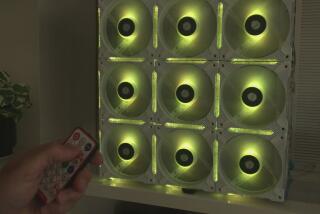UV-C wand touted as super-weapon against germs
For all the trouble they cause, bacteria and viruses are actually very fragile. Shower them with a little bleach or Lysol and they’ll die in apocalyptic waves. Make their homes too dry, too cold or too hot and they’ll drop like microscopic flies.
Ultraviolet light -- more specifically, short wavelength ultraviolet light, or UV-C -- kills germs too. In nature, UV-C is almost always absorbed by the atmosphere before it reaches Earth, but scientists have harnessed artificial UV-C rays to blast germs in labs, hospitals and water treatment plants.
If you’re afraid that germs have the upper hand in your kitchen or bathroom, you can bring the power of UV-C rays home. Several portable UV-C devices promise to help you kill bacteria and viruses wherever they hide.
One especially popular example is the UV-C Light Wand from Germ Guardian. The wand is 21 inches long and weighs 1 pound. Available at Lowe’s, Costco and online, it costs about $130. Germ Guardian also offers a Mini Sanitizer Wand that’s a little less than 12 inches long, weighs about a half-pound and costs about $60. Both types run on four AA batteries.
Users are encouraged to use the wand on all sorts of potentially germ-ridden places, including cutting boards, kitchen countertops, floors, waste baskets, doorknobs, remote controls, toys, motel bedspreads, toothbrushes and pet bowls. According to the Germ Guardian website, the device works best if held 2 inches away from the target for at least 20 seconds.
The claims
The Germ Guardian website claims that the wands “kill up to 99 percent of germs on surfaces using natural UV-C light -- not harmful chemicals.”
Chris Keller, marketing manager at Germ Guardian, says that “UV-C light is a proven technology for killing germs” that works well on any hard surfaces.
The bottom line
UV-C rays definitely kill germs, but it’s still not clear that sanitizing wands make homes significantly cleaner or healthier, says Elizabeth Scott, an assistant professor of biology at Simmons College in Boston and the co-director and founder of the Simmons Center for Hygiene and Health in Home and Community Settings, a research center.
“I don’t see a lot of potential for this kind of product,” Scott says. “We don’t have any evidence that these wands work.” Although many studies have investigated UV-C in labs, she says, no one to her knowledge has ever checked to see if portable devices can prevent diseases and infections in the home.
Even if the device really can kill 99% of germs on surfaces, that isn’t necessarily enough to prevent disease, Scott says. “For [disease-causing] germs, 99% isn’t enough. If you started with a million germs, you still have 10,000 that can make you sick.”
Dr. Donald Milton, a professor in the School of Health and Environment at the University of Massachusetts Lowell who studies industrial and clinical applications of UV-C, sees many obstacles to UV-C in the home.
For one thing, Milton says, UV-C wands wouldn’t do much to stop airborne germs, a potentially important cause of flu and other illnesses.
He also believes that the rays would have a difficult time reaching all of the nooks where germs hide. Even something as simple as a doorknob would have shadowy places where the light wouldn’t shine, he explains. And because UV-C rays don’t travel well through grease or grime, he says the wand would be only marginally helpful in the kitchen. “It might help a little bit, but washing would be a lot better and a lot cheaper.”
According to Keller, the wand works best when combined with more traditional cleaning strategies. For example, she recommends washing a cutting board with soap and water before using the wand.
Keller advises customers to use caution, because UV-C rays can damage skin and eyes. The wand automatically shuts off when turned upside down, but some users may still want to wear goggles to protect their eyes, she says.
Kelly Reynolds, an associate professor of public health at the University of Arizona in Tucson and a paid consultant for Germ Guardian, says the UV-C wand is a “great product,” although she’s never put it to any formal tests. “I’m a big promoter of disinfecting and sanitizing,” she says. “Plenty of studies show that UV-C kills germs.”
But the prospect of sanitizing a house 21 inches at a time with a UV-C wand strikes Scott as ridiculous. “They’re playing on people’s fears,” she says. “People’s logic flies out the window when their fears are aroused.”
Is there a consumer product you’d like the Healthy Skeptic to examine? E-mail [email protected]. Read more Healthy Skeptic columns at latimes.com/skeptic.





